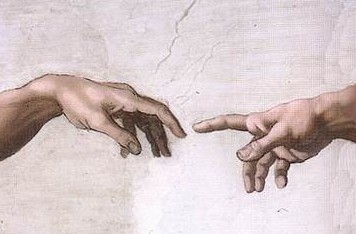As the kids got closer to high school, I started looking for an art history curriculum for them to use. Sadly, the pickings are a little slim. I found a variety of resources geared to younger students, but high school was almost non-existent. So when we were given the chance to review a new art history curriculum called The Master and His Apprentices: Art History from a Christian Perspective, I was eagerly hoping it would be a fantastic fit for our homeschooling. This new high school art history program from The Master and His Apprentices is geared to the Christian homeschooling family.
The Master and His Apprentices:Art History from a Christian Perspective is a full art history curriculum. It is written from a Christian point of view, contains no nudity or any other objectionable material.
For this review, we received the digital textbook and the digital teacher's guide. The digital books come in a fixed layout downloadable PDF. Due to the size of the book, it is recommended to view them on a computer and not a tablet. The textbook and the teacher's guide are also available in a physical copy.
Digitale Textbook~ $34.99
Hardcover Textbook~ $149.99
Digital Teacher's Guide~ $19.99
Softcover Teacher's Guide~ $24.99
*Prices are subject to change.
The digital textbook can be printed at home and stored in a three ring binder. We received instructions on how to do this. I chose not to print the book out. It's a large book and contains a large amount of colored pictures. It just didn't seem cost effective to me.
The hardcover textbook is 380 pages and contains over 600 pictures. Over 500 of those pictures are colored. The book is 8 1/2 by 11 in size, so it's a standard textbook. The softcover teacher's guide is the same size as the textbook. It contains 120 perforated pages.
The Master and His Apprentices: Art History from a Christian Perspective covers the history of art from the beginning to now. The program in intended for high school students. The course intended to be used by students for a full year (1 credit). Students will cover one chapter a week. The book is broken up into 5 units and there are 19 chapters in the book.
The Beginning
Chapter 1~ Introduction to Art
Chapter 2~ Creation
Ancient Cultures
Chapter 3~ Ancient Near East
Chapter 4~ Egyptian
Chapter 5~ Aegean
Classical Antiquity
Chapter 6~ Early Greek
Chapter 7~ Etruscan
Chapter 8~ Roman
Middle Ages
Chapter 9~ Early Christian & Byzantine
Chapter 10~ Medieval & Islamic
Chapter 11~ Romanesque
Chapter 12~ Gothic
Renaissance
Chapter 13~ Proto-Renaissance
Chapter 14~ Early Italian Renaissance
Chapter 15~ High Italian Renaissance
Chapter 16~ Northern Renaissance
Baroque & Beyond
Chapter 17~ Baroque
Chapter 18~ Rococo to Today
Chapter 19~ Global Highights
At the end of the books is the Appendix. It contains a few essays, a period chart, a timeline, a list of pieces by location, a list of terms to describe art, a sources list, and an index.
Students will learn about great sculptures and painters, like Fra Angelico, Michelangelo, DaVinci, Vermeer, and Bernini. They will study ancient artifacts, beautiful cathedrals, and stunning works of art.
How Did We Use The Master and His Apprentices?
After downloading the book to my computer, I forwarded it to my kids so they could have it on their own personal computers. This made it easy for everyone to read and follow along. We jumped right into the first chapter, which was a introduction of what art is. For us, this chapter a sort of a recap. My kids have studied over since we started homeschooling. Our Catholic religion books and history curriculum have been wonderful at introducing Michael and Therese to beautiful works of art and talented artist. I enjoyed how this chapter encouraged students to ponder what they think art is. I loved how it stressed that God is the best artist out there. There is no way we can walk around and not see the beauty he has created for us.
The second chapter focused on the days of creation. This chapter felt like a recap of the bible or religion class. I personally didn't find too much art history in this section. It had a lot of other useful information. Students will learn about creation, how things in the world works (water cycle), and how we should be grateful for all the amazing things God created for us.
Chapter 3 and chapter 4 is when we really started learning about art history. This chapter took us back to ancient times. We learned about the Persian Empire and the Ancient Wonders of the World. The kids were thrilled to learn about the Ziggurats again. They had previously learned about them a few years ago when we studied ancient history. I was amazed to see what they had remembered from our co-op and history curriculum. It's always a win when a mama sees her hard work pay off!
What Does the Teacher Guide Include?
The teacher's guide is 116 pages. I did print this out for my own personal use. I printed it out, 3-hole punched the pages and put it in a 3 ring binder! Simple and easy. The teacher's guide provides moms (teachers) with a suggested time frame. There is a sample syllabus for students and classes. Suggested reading schedules are provided, worksheets for the students to fill in, exams, a guide for teachers to follow, an answer key for the worksheets and exams, and options for writing! Everything you need to teach this art history course is included in the teacher's guide!
What Did We Think of The Master and His Apprentices?
Overall, the book is extremely well done. The pictures are stunning! There are a ton of them, over 600 pictures! They're clear, bright, and wonderful quality. The variety was exceptional....paintings, artifacts, cathedrals, mosicas, etc. There is no way you can study art history from a book without fantistics pictures. I can't stress how amazing the pictures are!
Unlike many other art history books, there are no nude pictures included. For me personally this isn't an issue. However when my kids were little, I would have loved this. For years, I taught an art class at co-op and always had to be careful with pictures. With different families views, it would have been nice to have an art history book without naked people. Little kids tend to giggle when they see naked people, which can really disrupt a class. For my own kids, I never hid the beauty of the body God created. I have never viewed the naked forms in artwork as inappropriate. It was art.
The timelines provided in the book are a great feature. They help students see when and how things progressed. Too often students study a topic and have no clue where it falls in the grand scheme of things.
I'll be honest...I hate reading books on the computer! I would much prefer an actual book in my hands. However, for the budget conscious homeschool family, a $150 for a textbook is just not feasible. The option of the digital book is a nice. It allows families with a limited budget to still have access to great materials.
The historical information was very good. The author provided a lot of facts and definitely spent time researching the various time periods and works of art. There were a few instances were I felt the author was presenting her own personal opinions. At times, it felt like story time. This was a turn off for me. In high school and college when I studied art, I don't remember our books containing the personal views of the author. Others may find this particular style appealing. I would for younger students, but not for high school. This style would be a better fit for students in 5th-8th grade.
For us, this art history course was not the best fit. It came close to what I was searching for, but did have a few concerns for me. The textbook is written from a Christian point of view, but isn't necessarily friendly to those of the Catholic faith. I felt it was more of a protestant point of view. The first few chapters about the ancient cultures were relatively harmless, but as I read further in the textbook I found a few things that definitely came across inaccurate for what we believe as Catholics. It was nothing we hadn't come across before, so I knew we could work around it. We have a strong religion and ancient history course that teaches my kids their faith, so I know they are strong in their faith. We'll continue to use The Masters and His Apprentices along with our other courses. It would be a great learning tool for both Michael and Therese. It will help them learn how to defend their faith to others.
Overall, I will say I would recommend the program. The pictures are fantastic ( I know I've already said that, but they really are) and the book does contain a wealth of knowledge. I would definitely let my fellow homeschooling families (Catholic and non-Catholic) know of my concerns with the curriculum. There are very few art history courses out there for homeschoolers. This course could be a wonderful addition to any homeschooling curriculum. I wish I would have kept my high school and college books, but sadly I didn't. As we continue to use the course, I will add additional books and information for my kids.
Find out more about The Master and His Apprentices: Art History from a Christian Perspective...
Discover what the rest of the crew had to say about The Master and His Apprentices:Art History from a Christian Perspective.
Till Next Time,
Monique













































